
Photo Credit:
© Wildlife Conservation Society
Lorem ipsum dolor sit amet, consectetur adipiscing elit. Sed a massa vel elit finibus sodales nec quis mi. In eu lorem volutpat, blandit erat at, finibus sapien. Vestibulum volutpat dui vitae cursus sollicitudin. Donec et dictum augue. Nulla pulvinar nisl id fringilla dictum. Maecenas congue viverra arcu non egestas. Nullam sit amet lacus tincidunt, ultricies mauris quis, accumsan neque.
Integer et vulputate leo, id ullamcorper nisi. Sed pellentesque convallis enim fermentum laoreet. Vestibulum eget velit ac libero pellentesque placerat quis quis nibh. Nunc facilisis ullamcorper odio, at tincidunt nulla egestas ac. Mauris id tortor placerat, dignissim est ac, varius enim. Nulla consequat dictum neque, in volutpat eros cursus eu. Lorem ipsum dolor sit amet, consectetur adipiscing elit.